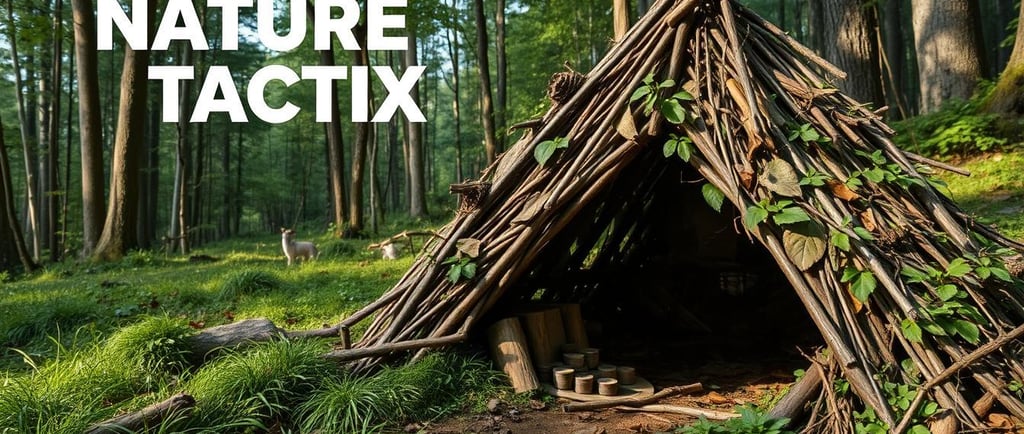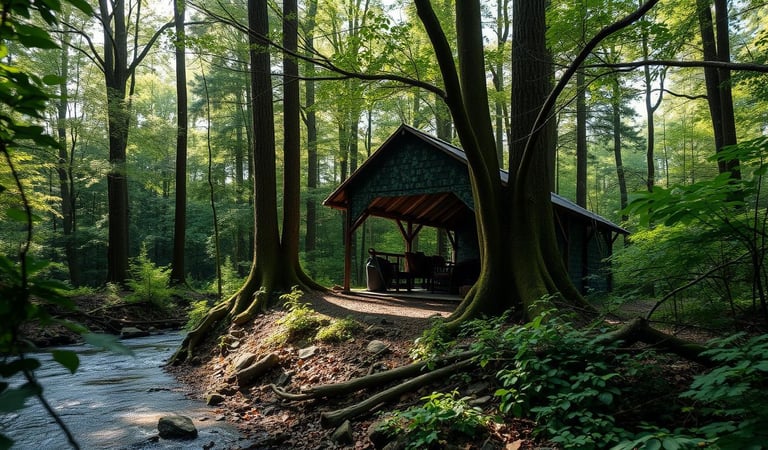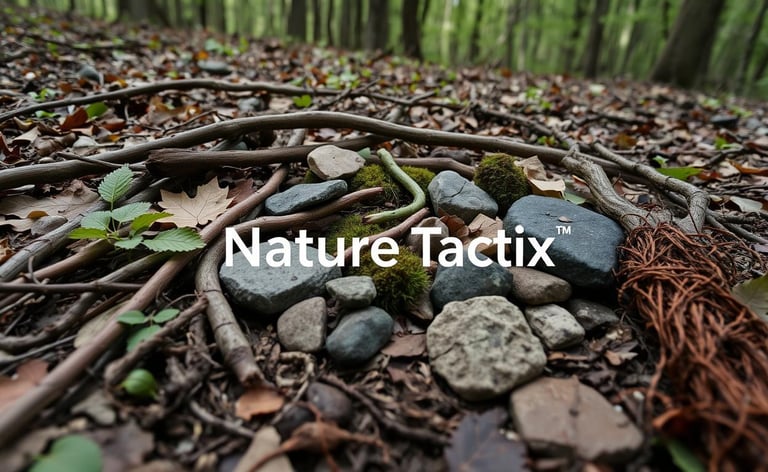
Building a Natural Camouflage Shelter: Quick Guide
Learn essential techniques for The Art of Building a Natural Camouflage Shelter using natural materials. I'll show you how to create a hidden, weatherproof sanctuary in the wilderness.
SURVIVAL POSTS
Kathrine-Anne Hill
11/9/202411 min read


Affiliate Disclosure:
Please note that some of the links in this article are affiliate links. This means that if you click on these links and make a purchase, I may receive a small commission at no additional cost to you. This commission helps support the maintenance and growth of this website and allows me to continue providing valuable information and recommendations. Rest assured, I only recommend products and services that I have personally used or thoroughly researched. Your support is greatly appreciated! For full disclosure see our Privacy Policy and Terms and Conditions here.
Building a Natural Camouflage Shelter: Quick Guide
In the wilderness, the weather can be tough and unpredictable. Knowing how to build a good shelter is essential. What if you could make a shelter that's safe and blends in with nature? Sounds cool? Let's see how to make a hidden spot using nature's gifts.
Key Takeaways
Learning to build natural camouflage shelters is a key survival skill.
These shelters protect you from the weather and hide you from dangers.
Choosing the right spot, using local materials, and camouflage techniques are important.
Building and camouflaging your shelter right is key to staying safe in the wild.
Using nature's resources and blending your shelter with the environment is key for survival.
Ready to learn how to build a natural camouflage shelter? It will keep you safe and hidden in the wild. Let's begin!
Understanding Natural Camouflage Shelter Basics
Building a natural camouflage shelter is important in bushcraft and nature-inspired design. These shelters hide and protect you from the weather. They do this by hiding and building stealthily.
Essential Elements of Wilderness Concealment
To blend in, picking the right materials is key. In mountains, use greys, greens, and browns. In jungles, choose verdant colors. Avoid straight lines and man-made shapes to stay hidden.
Why Natural Camouflage Matters
Natural camouflage shelters are vital for survival, hunting, and military use. They protect from the weather and keep you hidden. This makes them great for hiding, watching, or as a safe spot.
Core Principles of Stealth Shelter Building
Stealth shelter building is about being adaptable and aware of your environment. Know your local plants and animals, and the seasons. Use this knowledge to build a shelter that fits the terrain and weather. This way, your shelter will be both hidden and useful.
Learning to build natural camouflage shelters is a valuable skill. It gives you security, self-reliance, and a connection to nature. By mastering these skills, you can explore the world of bushcraft, nature-inspired architecture, and environmental adaptation.
Selecting the Perfect Location for Your Hidden Shelter
Finding the right spot is key for a natural camouflage shelter. It needs to protect you, be easy to get to, and blend in with nature.
Start by choosing high ground to avoid flooding. This keeps you safe and lets you see around you better. You can spot dangers or find useful things more easily.
Think about the sun and wind too. Find a place that blocks some of these, like thick trees or rocks. Being close to water and firewood is also important for staying comfortable and alive.
Avoid areas with overhead dead wood (known as "widow makers") that could pose a danger during storms.
Look for natural features that can enhance the camouflage of your shelter, such as thick undergrowth, boulders, or fallen logs.
The ideal location should balance protection, resource accessibility, and seamless integration with the surrounding outdoor shelters.
Choosing the right spot for your shelter helps you stay hidden. It also makes sure your wilderness survival skills work well, even when things get tough.
The Art of Building a Natural Camouflage Shelter
Making a natural camouflage shelter is like art. You need to pick the right materials and build it carefully. With natural materials engineering, you can make a hidden place that looks like it's part of nature. It keeps you safe and hidden.
Natural Materials Selection
Choosing the right materials is key to a good camouflage shelter. Look for fallen trees, branches, leaves, and other forest stuff. These pieces help build your shelter and hide it in the landscape.
Construction Techniques
Learning how to build is important for a good camouflage shelter. You can use lean-to, A-frame, or fallen tree shelters, depending on where you are and what you have. Try using palm fronds or bamboo to make strong and warm shelters.
Camouflage Integration Methods
The last step is to make your shelter look like it's always been there. Use mud and attach plants to make it blend in. Match the shelter's look and color to the surroundings. This makes your primitive shelter construction skills even better.
By using natural materials engineering and careful building and camouflage, you can make a shelter. It will protect and hide you in the wild.
Essential Tools and Materials from Nature
Nature is full of tools and materials for making a natural camouflage shelter. Sturdy branches can be the base, while leaves and pine needles keep you warm. Vines and other flexible plants are great for tying things together.
Rocks are also key, for shaping and sharpening, or to strengthen your shelter. In tropical areas, bamboo and palm fronds are perfect for structure and hiding. Mud is great for binding and hiding your shelter, making it blend in.
It's important to know what materials are in your area. This way, you can make a shelter that looks like it's always been there. It becomes a part of the landscape.
By using what nature offers, you can make a shelter that's hard to see. This skill in bushcraft and wilderness survival is key for making a good shelter outdoors.
Creating an Effective Mud-Based Camouflage
Blending into the environment is key for successful wilderness concealment. Mud-based applications are among the most effective camouflage techniques. By covering your shelter or body with clay-rich mud, you can blend in naturally.
Mud Application Techniques
First, collect a lot of damp, clay-based mud. Spread it all over your shelter, making sure it's fully covered. While the mud is wet, add leaves, twigs, and other debris to give it a realistic look. This method also keeps bugs away and helps keep you warm.
Adding Natural Debris
Get different types of local leaves, branches, and plants to mix into the mud.
Press these materials into the wet mud to make sure they stick well.
The more varied the debris, the better your camouflage will look.
Maintenance and Durability
As the mud dries and cracks, you'll need to keep it up to keep your camouflage working. Reapply the mud and add new debris to keep it looking weathered. With the right care, your camouflage will last a long time, adapting to changes in the environment.
"Camouflage is the most important aspect of survival, whether in the jungle or in the business world." - Naveen Jain
Advanced Shelter Design Strategies
Advanced design strategies are key in nature-inspired architecture and primitive shelter construction. Using natural terrain and camouflage are essential for effective and lasting shelters in the wild.
Building shelters partially underground or into hillsides is a good idea. It offers better insulation and hides from the elements. Using fallen trees and natural materials helps blend the shelter into the landscape.
Designing shelters with multiple entrances is another smart move. It boosts safety, improves air flow, and makes the shelter harder to find. Adding features like food storage and water collection systems can make a shelter self-sufficient.
The best shelters adapt to their environment and seasonal changes. By following nature-inspired architecture and primitive shelter construction principles, you can create a shelter that's both safe and comfortable for a long time.
Natural Insulation Techniques
Making a cozy and weather-resistant shelter is key for survival outdoors. We use the environment's resources for natural insulation. This way, we can build snug shelters that protect us from the weather.
Local Vegetation Usage
The forest floor is full of natural insulation. Moss, pine needles, and dry leaves are great for insulation. They keep us warm and block cold, wind, and moisture.
Seasonal Adaptations
Shelter insulation changes with the seasons. In winter, we use more vegetation and a raised bed to stay warm. In summer, we focus on ventilation to keep cool and dry.
Weather Protection Methods
Keeping the weather out is vital. Angled roofs and dense vegetation or mud walls block rain and wind. A barrier between the ground and bed keeps us warm.
Natural insulation techniques help us build shelters that protect and blend with nature. These methods show how to adapt to the environment and use natural materials. They help us survive in tough wilderness conditions.
Integration with Surrounding Environment
It's important to blend your camouflage shelter with the area around it for good hiding. Match the natural shapes and plant patterns in your area. Using local plants to cover your shelter helps it blend in even more.
Stay away from straight lines and perfect shapes. They don't fit well in nature. Instead, aim to mix your shelter with the area's natural curves and patterns. Keep checking and tweaking your shelter to match the changing seasons and plants around it.
By matching your shelter closely with the environmental adaptation, you use camouflage techniques to hide well. This not only makes your hiding spot better but also helps protect the area you're in.
"When repainting Canyon Ranch, a spa and wellness center, every building on 50 acres was transformed using a palette inspired by the local landscape, such as the colors of the desert sunrise, cactus, rock formations, and manzanita bark."
Maintaining Your Camouflage Shelter
Keeping your outdoor shelter in good shape is key for a great wilderness adventure. You need to do regular maintenance, adjust for the weather, and use techniques to make it last longer. This will keep your camouflage shelter working well.
Regular Maintenance Tasks
Check your shelter often for any weak spots or damage. Fix any issues, like loose parts, and fluff up insulation that's compressed or damp. Make sure the entrance cover is right for air and weather protection.
Watch out for pests and deal with them fast to keep your shelter strong. Being careful and quick with these tasks will help you avoid problems. It will also make sure your shelter stays a safe and reliable place.
Weather-Related Adjustments
It's important to change your shelter as the weather does. Strengthen it against strong winds or heavy rain by making the right changes. If you have a fire nearby, make sure it's safe to avoid damaging your shelter.
Pay attention to the weather forecast and adjust your shelter as needed. This will help protect your outdoor shelter. It will keep it safe from the elements, no matter what they bring.
Longevity Enhancement Tips
To make your camouflage shelter last longer, add features that make it stronger. Use natural debris or plants around it to blend in better. This will help it stay hidden.
Keep your camouflage up to date to keep your shelter hidden. Try different methods, like using mud or adding natural materials. This will help your shelter stay hidden and useful.
By spending time and effort on your outdoor shelter, you'll have a better wilderness experience. You'll stay safe and hidden for longer.
Common Mistakes to Avoid
Building a natural camouflage shelter is an art. It's important to avoid common mistakes for success. As you start building your shelter, remember these key errors to avoid:
Don't choose a spot that's prone to flooding or under trees that could fall. Pick a place that's naturally protected and fits well with the area around it.
Don't just use green materials. They shrink and change shape as they dry, which can ruin your shelter. Mix green and dry materials for the best results.
Insulation is key. Without it, your shelter can lose heat and feel cold. Use leaves, grass, and moss to keep it warm and cozy.
Avoid making your shelter look like it was made by humans. Try to blend it into the plants and terrain around it.
Your shelter needs regular care to last. Plan to make adjustments and repairs to keep it in good shape.
Make sure your shelter doesn't harm the local environment. Try to leave as little trace as possible.
By avoiding these mistakes, you can build a shelter that's well-designed, sustainable, and blends into the wilderness. This will improve your bushcraft and survival skills.
"The true essence of bushcraft lies in the ability to merge with the natural world, and crafting a camouflaged shelter is a testament to that art." - Survival Expert, Jane Doe
Safety Considerations and Best Practices
When building a natural camouflage shelter, safety comes first. It's important to be aware of your surroundings and follow Leave No Trace principles. This helps keep the wilderness in balance.
Environmental Awareness
Choose a shelter spot that doesn't harm the environment. Don't cut down trees or hurt plants. Use fallen or dead wood instead.
Also, watch out for poisonous plants and dangerous animals. Learn about their habits and habitats.
Emergency Protocols
Plan for emergencies before you go. Tell someone where you are and when you'll be back. Carry a first-aid kit, signaling tools, and a way to call for help.
Have a plan to leave quickly if needed. Knowing how to get help is key.
Risk Management
Manage risks when using your shelter. If you have a fire, make sure it's safe. Keep an eye on the weather and adjust your shelter as needed.
Being prepared and alert can make your time in the wilderness safer and more enjoyable.
Related Posts:
How to Build a Basic Emergency Shelter: Essential Gear and Options
FAQ
What are the essential elements of a natural camouflage shelter?
To build a natural camouflage shelter, use local materials. Mimic natural patterns and avoid human-made shapes. This helps you blend in with your surroundings.
Why is natural camouflage important for wilderness survival?
Natural camouflage is key for survival and hunting. It helps you stay hidden from threats. It also lets you connect with nature.
What are the core principles of building a stealth shelter?
The main steps are choosing the right materials and understanding local plants. Adapt to the seasons to make a shelter that's both hidden and useful.
How do I choose the ideal location for a natural camouflage shelter?
Pick a spot on high ground to avoid floods. Consider the sun and wind. Be close to water and firewood. Look for places with lots of foliage or rocks for extra cover.
What natural materials can I use to build a camouflage shelter?
Use fallen trees, branches, and leaves to build your shelter. Add moss, pine needles, and dry leaves for warmth.
How do I effectively camouflage my shelter using mud?
Start with a wet clay-mud layer on the outside. Add leaves and twigs while it's wet. This makes your shelter blend in and keeps you warm.
What are some advanced techniques for designing a camouflage shelter?
Build your shelter partly underground or into hillsides for better warmth and hiding. Use fallen trees as a base. Add entrances for safety and air. Think about long-term needs, like food and water storage.
How do I ensure proper insulation for my natural camouflage shelter?
Use moss, pine needles, and dry leaves for warmth. Change your insulation with the seasons. Keep the ground away from your bed with boughs or platforms.
What are some common mistakes to avoid when building a natural camouflage shelter?
Don't ignore the right spot, only use green materials, or forget insulation. Avoid obvious human shapes. Think about the shelter's long-term upkeep and its effect on nature.
What safety considerations should I keep in mind?
Be mindful of your impact on nature and follow Leave No Trace. Have plans for emergencies and know about local dangers. Make sure your shelter has air if you use fire.








